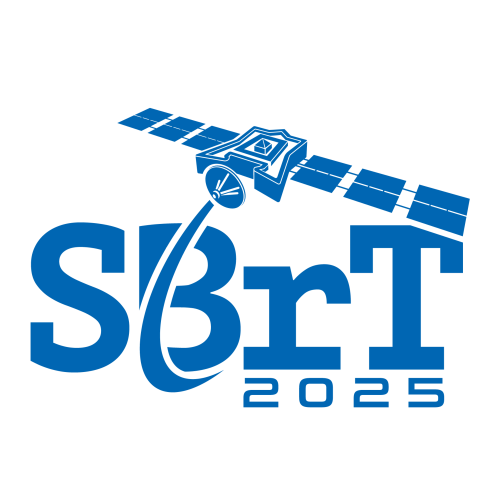
XLIII Simpósio Brasileiro de Telecomunicações e Processamento de Sinais
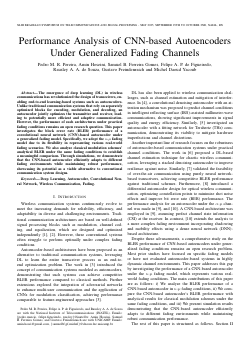
Performance Analysis of CNN-based Autoencoders Under Generalized Fading Channels
Pedro Marcio Raposo Pereira, Amin Hoseini, Samuel Gomes, Felipe Augusto Pereira de Figueiredo, Rausley Adriano Amaral de Souza, Gustavo Fraidenraich, Michel Daoud Yacoub
DOI: 10.14209/sbrt.2025.1571137448
Keywords: Deep learning Autoencoder Convolutional Neural Network Wireless Communication
Abstract
The emergence of \ac{DL} in wireless communications has revolutionized the design of transceivers, enabling end-to-end learning-based systems such as autoencoders. Unlike traditional communication systems that rely on separately optimized blocks for encoding, modulation, and decoding, an autoencoder jointly optimizes the transmitter and receiver, leading to potentially more efficient and adaptive communication. However, the performance of such architectures under practical fading conditions remains an open research question. This paper investigates the \ac{BLER} performance of a \ac{CNN}-based autoencoder under a generalized fading model. Specifically, we adopt the \(\kappa\)-\(\mu\) fading model due to its flexibility in representing various real-world fading scenarios. We also analyze classical modulation schemes' analytical \ac{BLER} under the same fading conditions to establish a meaningful comparison. Through simulations, we demonstrate that the \ac{CNN}-based autoencoder efficiently adapts to different fading environments while maintaining robust performance, showcasing its potential as a viable alternative to conventional communication system designs.Download
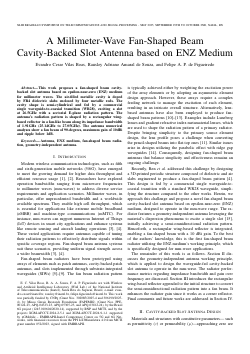
A Millimeter-Wave Fan-Shaped Beam Cavity-Backed Slot Antenna based on ENZ Medium
Evandro Cesar Vilas Boas, Rausley Adriano Amaral de Souza, Felipe Augusto Pereira de Figueiredo
DOI: 10.14209/sbrt.2025.1571137590
Keywords:
Abstract
This work proposes a fan-shaped beam cavity-backed slot antenna based on epsilon-near-zero (ENZ) medium for millimeter waves. The air-filled metallic cavity is doped by FR4 dielectric slabs enclosed by four metallic rods. The cavity shape is semi-cylindrical and fed by a commercial single waveguide-to-coaxial transition (WR28), exciting a slot at 26.5GHz with a sectorial E-plane radiation pattern. The antenna's radiation pattern is shaped by a rectangular wing-based reflector in a fan-like beam along its impedance bandwidth of 7.31GHz (25.14GHz to 27.05GHz). The antenna numerical analyses show a fan beam of 90-degrees, maximum gain of 10dBi and ripple below 1dB.Download

Optimization of STAR-RIS-assisted WET Systems Based on IoT Device Selection
Rogério Pereira Júnior, Victoria Souto, Richard Demo Souza
DOI: 10.14209/sbrt.2025.1571138471
Keywords: Wireless Energy Transfer Ant Colony Optimization Beamforming
Abstract
In this paper, we evaluate a Wireless Energy Transfer (WET) system assisted by a Simultaneous Transmission and Reflection Reconfigurable Intelligent Surfaces (STAR-RIS) and consider the concept of beamsharing, which allows IoT devices to harvest energy even while others are actively being charged. Then, determining the optimal charging sequence is critical, as it directly impacts the total time required to charge all devices. To tackle this challenge, we propose an Ant Colony Optimization (ACO)-based approach to optimize the charging order, minimizing the overall system charging time. Furthermore, given that perfect Channel State Information (CSI) is challenging and often unavailable in practical scenarios, we propose a design methodology based on Statistical CSI (S-CSI) to optimize both the beamforming at the power beacon (PB) and the phase and amplitude configurations of the STAR-RIS elements. Our results demonstrate that the proposed solution achieves near-optimal performance and reduces the total charging time by at least 23% compared to a random selection benchmark.Download

Towards Network Data Analytics in 5G Systems and Beyond
Marcos Lima Romero, Ricardo Suyama
DOI: 10.14209/sbrt.2025.1571141712
Keywords: NWDAF Data Analytics Machine Learning 5G
Abstract
Data has become a critical asset in the digital economy, yet it remains underutilized by Mobile Network Operators (MNOs), unlike Over-the-Top (OTT) players that lead global market valuations. To move beyond the commoditization of connectivity and deliver greater value to customers, data analytics emerges as a strategic enabler. Using data efficiently is essential for unlocking new service opportunities, optimizing operational efficiency, and mitigating operational and business risks. Since Release 15, the 3rd Generation Partnership Project (3GPP) has introduced the Network Data Analytics Function (NWDAF) to provide powerful insights and predictions using data collected across mobile networks, supporting both user-centric and network-oriented use cases. However, academic research has largely focused on a limited set of methods and use cases, driven by the availability of datasets, restricting broader exploration. This study analyzes trends and gaps in more than 70 articles and proposes two novel use cases to promote the adoption of NWDAF and explore its potential for monetization.Download
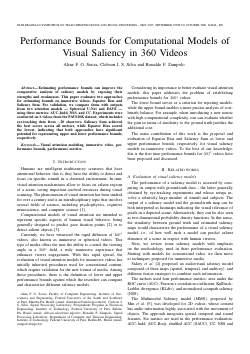
Performance Bounds for Computational Models of Visual Saliency in 360 Videos
Aline F. G. Sousa, Clebson I. S. Silva, Ronaldo F Zampolo
DOI: 10.14209/sbrt.2025.1571142924
Keywords: Visual attention modeling immersive video performance bounds performance metrics
Abstract
Estimating performance bounds can improve the comparative analysis of saliency models by exposing their strengths and weaknesses. This paper evaluates two approaches for estimating bounds on immersive videos: Equator Bias and Saliency Sum. For validation, we compare them with outputs from two attention models - Spherical U-Net and DAVE - using three metrics: AUC-Judd, NSS, and CC. Experiments were conducted on 6 videos from the PAVS10K dataset, which includes eye-tracking data from ~20 observers. Saliency Sum achieved the best scores across all metrics, while Equator Bias scored the lowest, indicating that both approaches have significant potential for representing upper and lower performance bounds, respectively.Download
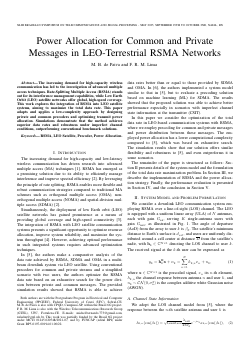
Power Allocation for Common and Private Messages in LEO-Terrestrial RSMA Networks
Michel Bernardo de Paiva, Francisco Rafael Marques Lima
DOI: 10.14209/sbrt.2025.1571143051
Keywords: RSMA LEO Satellite Precoder Power Allocation
Abstract
The increasing demand for high-capacity wireless communication has led to the investigation of advanced multiple access techniques. Rate Splitting Multiple Access (RSMA) stands out for its interference management capabilities, while Low Earth Orbit (LEO) satellite networks offer global, high-speed coverage. This work explores the integration of RSMA into LEO satellite systems, aiming to maximize the total data rate. We propose a low-complexity approach by designing private and common precoders and optimizing transmit power allocation. Simulations demonstrate that the method achieves superior data rates and robustness under imperfect channel conditions, outperforming conventional benchmark solutions.Download
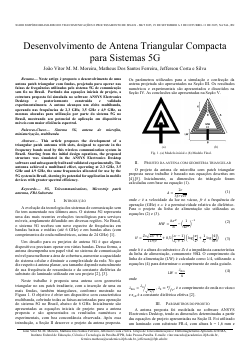
Desenvolvimento de Antena Triangular Compacta para Sistemas 5G
João Vítor Macedo De Melo Moreira, Matheus Santos Ferreira, Jefferson Costa Silva
DOI: 10.14209/sbrt.2025.1571143182
Keywords:
Abstract
Considering the demands of fifth generation mobile communication system technology (5G), this paper proposes the development of a compact triangular patch antenna with slots, designed to operate in the frequency bands used by this wireless communication system in Brazil. Starting from the initial design equations, the proposed structure was simulated using ANSYS HFSS (High Frequency Structure Simulator) software and then built and validated experimentally through measurements at IFPB's Telecommunications Measurements Laboratory. The results obtained show the effect of miniaturization. The antenna achieved a multiband effect, operating at 2.3 GHz, 3.5 GHz and 4.9 GHz, the same frequencies allocated for use by the 5G system in Brazil, showing its potential for application in mobile devices with greater spectral efficiency.Download
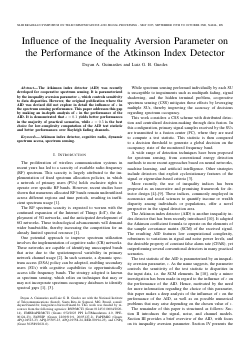
Influence of the Inequality Aversion Parameter on the Performance of the Atkinson Index Detector
Dayan A. Guimarães, Luiz Gustavo B. Guedes
DOI: 10.14209/sbrt.2025.1571143516
Keywords:
Abstract
The Atkinson index detector (AID) was recently developed for cooperative spectrum sensing. It is parameterized by the inequality aversion parameter E, which controls sensitivity to data disparities. However, the original publication where the AID was devised did not explore in detail the influence of E in the spectrum sensing performance. This paper addresses this gap by making an in-depth analysis of E in the performance of the AID. It is demonstrated that E=0.1 yields better performances in the majority of practical scenarios, while E=0.5 is the best choice for low-complexity computation of the AID test statistic and better performances in Rayleigh fading channels.Download

Microwave Sensor with Hairpin Resonator-Based Line and Defected Ground Structure
Bruno Matias de Sousa, Valdemir Praxedes da Silva Neto, José Patrocínio da Silva
DOI: 10.14209/sbrt.2025.1571143578
Keywords: Microwave sensor Hairpin topology Thue-Morse sequence
Abstract
This article proposes a Defect Ground Structure (DGS) based on the Thue-Morse sequence with a Hairpin-Based sensor optimized for S-band applications. The microwave sensor operates within a frequency range of 2.27 to 2.42 GHz and is constructed on a printed circuit board with a copper foil and FR-4 substrate, with a permittivity of 4.4 and a loss tangent of 0.02. The measured bandwidth was around 160 MHz and the transmission coefficient was -25 dB, with an average sensitivity measurement of 0.76% on the sensor. Despite a minor discrepancy observed in the return loss response value between the measured and simulated values, the proposed sensor is applicable to frequencies within the 2 to 4 GHz S-band.Download
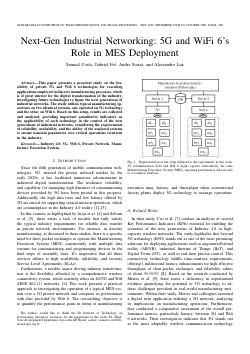
Next-Gen Industrial Networking: 5G and WiFi 6's Role in MES Deployment
Samuel Costa, Gabriel Fré, André Souza, Alessandro Luz Sr.
DOI: 10.14209/sbrt.2025.1571143827
Keywords: Industry 4.0 5G Wifi 6 Private Network
Abstract
This paper presents a practical study on the feasibility of private 5G and Wifi 6 technologies for executing applications employed in discrete manufacturing processes, which is of great interest for the digital transformation of the industry, investigating future technologies to figure the next generations of industrial networks. The study utilizes typical manufacturing operations on two identical systems, one operated on 5G technology and the other on Wifi 6. Based on this setup, results are collected and analyzed, providing important quantitative indicators on the applicability of each technology in the context of the next generations of industrial networks, considering the requirements of reliability, availability, and the ability of the analyzed systems to ensure nominal parameters over critical operations recurrent in the industry.Download